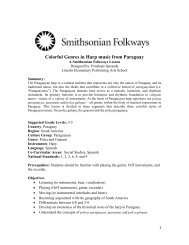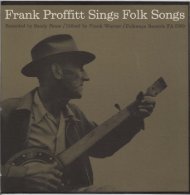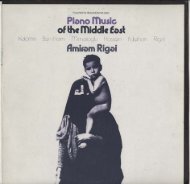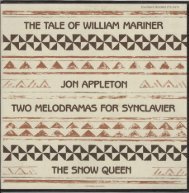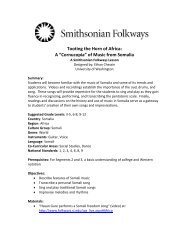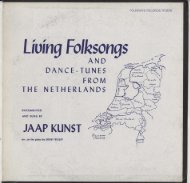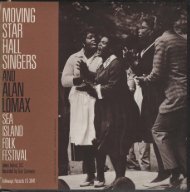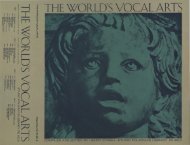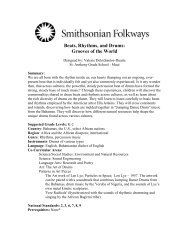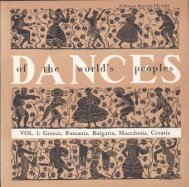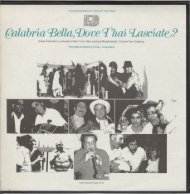<strong>Music</strong> <strong>of</strong> <strong>the</strong> <strong>Waswahili</strong> <strong>of</strong> <strong>Lamu</strong>, <strong>Kenya</strong>Collected and annotated by Alan W. BoydSwahili is one <strong>of</strong> <strong>the</strong> most widely known ethnicnames <strong>of</strong> Africa. It is associated with <strong>Kenya</strong> and Jomo<strong>Kenya</strong>tta, Tanzania and Julius Nyerere and such wordsas simba, safari and ijumaa. Yet very little is commonlyknown about who <strong>the</strong> <strong>Waswahili</strong> (<strong>the</strong> Swahili people)are, where <strong>the</strong>y are located or what <strong>the</strong>ir culture is like.Swahili is thought to be an Africanized version <strong>of</strong> <strong>the</strong>Arabic term for coast, sahel The Waswahi/i are coastalpeople living in cities, towns and villages on <strong>the</strong> eaSternlittoral <strong>of</strong> Africa from Kilwa at <strong>the</strong> mouth <strong>of</strong> <strong>the</strong> RufijiRiver in <strong>the</strong> south to Mogadischu in Somalia in <strong>the</strong>north. The common characteristics <strong>of</strong> people whocan be called <strong>Waswahili</strong> are a more-or-less-knowndescent from Arabic families, especially from <strong>the</strong>sou<strong>the</strong>rnmost portions <strong>of</strong> <strong>the</strong> Arabian peninsula; <strong>the</strong>Muslim religiOUS faith; speaking a mutually understandabledialect <strong>of</strong> Kiswahili; and association with, ifnot actual occupation <strong>of</strong>, urban centers.Swahili culture and language are thought to haveoriginated long before <strong>the</strong> birth <strong>of</strong> <strong>the</strong> ProphetMuhammad with <strong>the</strong> contact between Arab traders,sailors and merchants, and Bantu groups along <strong>the</strong> FastAfrican coast. This process reached a high point during<strong>the</strong> internal struggles for preeminence in <strong>the</strong> enlargingMuslim world during <strong>the</strong> centuries following hisdeath. By <strong>the</strong> thirteenth century, Arabic settlementswere widespread along <strong>the</strong> whole <strong>of</strong> <strong>the</strong> Fast Africancoastline. From that time on, settlers arrived on <strong>the</strong>Fast African coast in successive waves. Descendants<strong>of</strong> earlier immigrants became more and moreAfricanized, so that today, although Arab influenceis readily perceived in much <strong>of</strong> Swahili culture, andmany people still maintain considerable contact with<strong>the</strong> Saudi Arabian peninsula, <strong>the</strong> culture is clearlyAfrican.The three volumes in this <strong>Waswahili</strong> series contain amusical portrait <strong>of</strong> Swahili culture as it exists in lamu.<strong>Kenya</strong>, and its environs. They clearly illustrate <strong>the</strong>deeply rooted Arabic influence, and yet <strong>the</strong>y alsodemonstrate <strong>the</strong> African foundations <strong>of</strong> Swahili culture.<strong>Lamu</strong> was chosen as <strong>the</strong> focus for this collectionand <strong>the</strong> research it represents because it has been acenter <strong>of</strong> Swahili culture for many centuries and isstill a relatively unadulterated location for Swahili life.This is not to say that all Kiswahili-speaking peopleare like <strong>the</strong> people <strong>of</strong> lamu, or that this collectionexhausts <strong>the</strong> variety <strong>of</strong> musical expression that can befound in Swahili towns, but it does represent Swahilimusical life well and provides examples <strong>of</strong> many <strong>of</strong><strong>the</strong> forms in common use. The notes for each bandprovide more detail on <strong>the</strong> styles <strong>of</strong> music as well asfur<strong>the</strong>r elaboration on <strong>the</strong> history <strong>of</strong> <strong>Lamu</strong>, Swahilisociety and <strong>the</strong> culture relevant to it.<strong>Music</strong> oj <strong>the</strong> Waswahilt oj <strong>Lamu</strong>, <strong>Kenya</strong>Volume IVolume IIVolume IIIMaulidiO<strong>the</strong>r Sacred <strong>Music</strong>Secular <strong>Music</strong><strong>Lamu</strong><strong>Lamu</strong>, <strong>Kenya</strong>, is at <strong>the</strong> same time, a district in <strong>the</strong>governmental segmentation <strong>of</strong> <strong>Kenya</strong>, an archipelago<strong>of</strong> islands <strong>of</strong>f <strong>the</strong> nor<strong>the</strong>ast coast <strong>of</strong> <strong>Kenya</strong>, one <strong>of</strong> <strong>the</strong>islands in that group, and <strong>the</strong> major town on thatisland (see Map I). <strong>Lamu</strong> Island, which is about tensquare miles in area, lies one hundred kilometers southlatitude. Directly to <strong>the</strong> north <strong>of</strong> <strong>Lamu</strong> is Manda Island,which is approximately <strong>the</strong> same size as <strong>the</strong> island <strong>of</strong><strong>Lamu</strong>, and north <strong>of</strong> Manda is Pate, <strong>the</strong> largest island <strong>of</strong><strong>the</strong> group, on which are found <strong>the</strong> towns <strong>of</strong> Pate, Faza (orRasinj) and Siyu, as well as a few o<strong>the</strong>r smaller villages.Although <strong>the</strong> exact dates <strong>of</strong> <strong>the</strong> first settlements on<strong>Lamu</strong> Island are not known, preliminary archeologicalexplorations suggest that settlements occurred in <strong>the</strong>vicinity <strong>of</strong> <strong>the</strong> present town at least as early as 1200 AD.lamu Island is a sand bar in <strong>the</strong> shape <strong>of</strong> a bow!. Thecenter holds fresh water, while <strong>the</strong> rim prevents <strong>the</strong>brackish sea water from penetrating <strong>the</strong> disc. Sincewells can be dug near <strong>the</strong> edge <strong>of</strong> <strong>the</strong> island, townscame to be established on its coast. The present daycity <strong>of</strong> <strong>Lamu</strong> lies on <strong>the</strong> nor<strong>the</strong>astern edge <strong>of</strong> this bowlin a protected bay. The town <strong>of</strong> Matandoni lies on <strong>the</strong>2
The lamu waterfront, a zeJe procession underwayopposite coast <strong>of</strong> <strong>the</strong> island and rests near <strong>the</strong> mouth<strong>of</strong> <strong>the</strong> lamu bay.lamu has never been an isolated community. Althoughit is not easily reached by land even today, it has alwaysbeen accessible by sea, ei<strong>the</strong>r from <strong>the</strong> north or <strong>the</strong>south, depending on which way <strong>the</strong> monsoon winds areblowing. The town has a rich history <strong>of</strong> conflict andalliance with neighboring towns, especially Pate.The Pate Chronicle, an indigenous description <strong>of</strong> <strong>the</strong>traditions and events in <strong>the</strong> history <strong>of</strong> Pate, which wasreduced to writing at <strong>the</strong> turn <strong>of</strong> <strong>the</strong> twentieth century,is full <strong>of</strong> references to political, economic and religiousdisputes with <strong>the</strong> inhabitants <strong>of</strong> lamu (Werner:1915).lamu's history, <strong>the</strong>n, indicates a pattern in which <strong>the</strong>town sought both religious and commercial independencefrom its neighbors, but was never able t<strong>of</strong>ully achieve ei<strong>the</strong>r. Today it is still a mixture <strong>of</strong> a desirefor independence and friendly relations with o<strong>the</strong>rpolitical bodies, so long as <strong>the</strong> interaction resultsin advantage to <strong>the</strong> leading families <strong>of</strong> lamu.Most residents <strong>of</strong> lamu today describe <strong>the</strong> townas divided into two halves-Mkomani to <strong>the</strong> north andLangoni to <strong>the</strong> south (see Map II). The nor<strong>the</strong>rn portionis characterized as <strong>the</strong> place <strong>of</strong> stone houses, whereold established families reside, while <strong>the</strong> sou<strong>the</strong>rn issaid to be <strong>the</strong> place where wageni, i.e., visitors, livein mud-walled, thatched-ro<strong>of</strong> houses.Persons from old, established families are proneto emphaSize <strong>the</strong> names <strong>of</strong> <strong>the</strong> two locations, to pointout wageni on <strong>the</strong> streets and to call attention towhere people live, whereas more recent settlers in<strong>the</strong> community pay less attention to <strong>the</strong> division.When <strong>the</strong>y speak <strong>of</strong> it at all, it is with a resentful tone<strong>of</strong> voice and a suggestion <strong>of</strong> defiance <strong>of</strong> an obsoletedistinction.Today, although <strong>the</strong> names <strong>of</strong> <strong>the</strong> divisions <strong>of</strong> <strong>the</strong>to\',ll1 are widely used and <strong>the</strong> social distinctions <strong>the</strong>yimply are !mown to nearly everyone living in lamu, <strong>the</strong>political structure that was once contained within <strong>the</strong>mhas been elaborated and modified. The existence <strong>of</strong>a modern, independent <strong>Kenya</strong> has brought a newdimension to lamu's political structure, which hasbeen partially assimilated into <strong>the</strong> old didemic arrangement,and which has partially changed to meet <strong>the</strong> neworder. A town council still exists, but instead <strong>of</strong> itsmembership consisting <strong>of</strong> leaders <strong>of</strong> <strong>the</strong> dominantfamilies, <strong>the</strong> wangwana, <strong>the</strong> positions are held byelected representatives, some <strong>of</strong> whom represent <strong>the</strong>interest <strong>of</strong> recent immigrants to <strong>the</strong> town or <strong>of</strong> recentlyenfranchised servant classes. Some <strong>of</strong> <strong>the</strong> prestigiouswazee, <strong>the</strong> leaders <strong>of</strong> important families, still exerciseinfluence upon <strong>the</strong> decision-making processes, but<strong>the</strong>y do so through behind-<strong>the</strong>-scenes pressure uponrelatives or allies from o<strong>the</strong>r families.The political organization <strong>of</strong> lamu is closely intertwinedwith <strong>the</strong> religiOUS organization, which exercisesgreat influence on every aspect <strong>of</strong> lamu society. "Islamhas an order <strong>of</strong> clergy but no priesthood" (Trimingham1962:37). The role <strong>of</strong> leadership in each local mosque3




